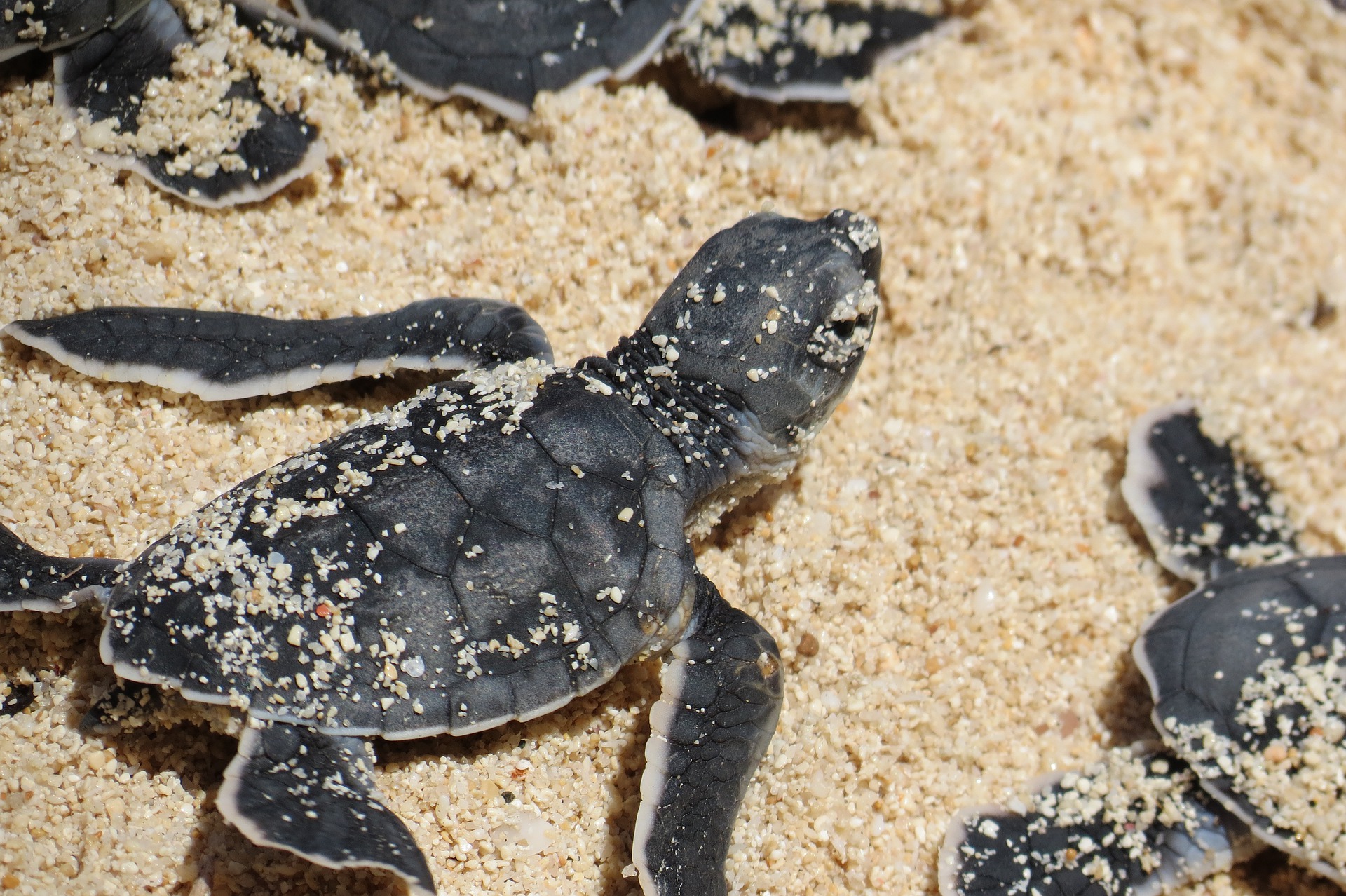Marine Life & Conservation Blogs
Turtles of the Riviera Maya & Cozumel

A blog by Pro Dive International
Plenty of empty shells of recently hatched turtle eggs were spotted by our divers at Sabalos. They had been washed off shore onto the reef after the baby turtles had dug out of their nest at night and swam off into the sea.
The turtle nesting season on the Riviera Maya and in Cozumel happens between May and October, which means that you may be lucky to see some nests or even hatchlings during your stay with us.
Six out of the seven sea turtle species worldwide visit Mexico every year. We are lucky enough to get to see Green Turtles and Loggerhead Turtles regularly during our dives, as they are in search of food and a good clean.
The reefs and ecosystems here provide a great number of tasty snacks for a turtle, for example seagrass, sponges, crustaceans and many more. And while the turtles pass through the reef, they receive a top-notch cleaning service from many of the local fishes who feed on their parasites and algae growth.
6 Turtle Fun Facts
- Green turtles are so named because of their green colored fat caused by their rich diet of seagrass.
- Green Turtles are the largest hard-shell turtles in the world. The largest known green turtle weighed 395 kg/ 871 lbs, with a shell that measured more than 152 cm/ 5 ft.
- Loggerhead Turtles are so named for their massive broad muscular heads.
- Adult males are normally easy to distinguish from females because of their long tails visible extending past their shell.
- Female turtles normally return to the exact same location where they were born to lay their eggs.
- The sex of a baby turtle is determined by the temperature at which the egg is kept.
Turtles are regular visitors to many of our dive sites, but they are most commonly found at Tortuga – this dive site is even named turtle in Spanish! It’s located just off shore from our dive center at the Occidental Xcaret and easily accessible by boat from any of our Playa Del Carmen locations.
Moreover, for those of you who are not divers, we are lucky enough to have some extensive seagrass beds where green turtles love to hang out and eat, which is an easy snorkel off shore during one of our tours with a guide who is licensed to enter those protected areas.
Turtle Locations
Besides observing them underwater, you may be lucky to find some turtle nests in front of your resort on the Riviera Maya or in Cozumel. Hotel employees usually rope them off to ensure their protection.
Turtle conservation projects are a great alternative to learn more about their behaviors, importance for the marine environment, how you can help protect them, and to observe nests or turtles first hand:
- Centro Ecológico Akumal – an NGO with a 28-year history
- Punta Sur Eco Beach Park – a 247-acre ecological park in Cozumel
- Sea Turtle Conservation Project Tulum by CONAP/ Flora, Fauna y Cultura de México
Turtle Protection
Every sea turtle species on earth nests on Mexico’s beaches (save one that is only found in Australia). Consequently, Mexico is known as the sea turtle capital of the world and its turtle protection laws are so important on a global scale.
Current Mexican law classifies all sea turtle species as endangered.
Regulations
- Turtles can’t be killed for their meat, skin, shell or eggs.
- Native vegetation can’t be removed in nesting habitats, to stop erosion.
- New regulations call for moving, changing or eliminating any light sources that illuminate a nesting beach, as baby turtles can become disoriented from finding their way to the ocean.
- Vehicles can have a maximum weight of 300 kg on nesting beaches and only be used for patrolling and management of the nesting site.
- Recently outlawed were turtle release events, as many places kept the hatchlings in confinement for several days until a sufficient number of participants had signed up for this activity. Upon release, they were too weak to handle the surf and avoid predators.
All of these and many more regulations help protect beaches, nests, female sea turtles, their eggs and hatchlings to make it a safer place for them.
How to start your Turtle Adventure
Let’s discover some turtles together during our dives! If you are not a diver, why not sign up for a PADI course; or join our Mexican Snorkeling Adventure at 15% OFF starting from Playa del Carmen or Tulum, if booked online until 16/09 & redeemed until Dec 22, with reference to this blog!
Marine Life & Conservation Blogs
Creature Feature: Dusky Shark

 In this series, the Shark Trust will be sharing amazing facts about different species of sharks and what you can do to help protect them.
In this series, the Shark Trust will be sharing amazing facts about different species of sharks and what you can do to help protect them.
This month we’re taking a look at the Dusky Shark, a highly migratory species with a particularly slow growth rate and late age at maturity.
Dusky sharks are one of the largest species within the Carcharhinus genus, generally measuring 3 metres total length but able to reach up to 4.2 metres. They are grey to grey-brown on their dorsal side and their fins usually have dusky margins, with the darkest tips on the caudal fin.
Dusky Sharks can often be confused with other species of the Carcharhinus genus, particularly the Galapagos Shark (Carcharhinus galapagensis). They have very similar external morphology, so it can be easier to ID to species level by taking location into account as the two species occupy very different ecological niches – Galapagos Sharks prefer offshore seamounts and islets, whilst duskies prefer continental margins.
Hybridisation:
A 2019 study found that Dusky Sharks are hybridising with Galapagos Sharks on the Eastern Tropical Pacific (Pazmiño et al., 2019). Hybridisation is when an animal breeds with an individual of another species to produce offspring (a hybrid). Hybrids are often infertile, but this study found that the hybrids were able to produce second generation hybrids!
Long distance swimmers:
Dusky sharks are highly mobile species, undertaking long migrations to stay in warm waters throughout the winter. In the Northern Hemisphere, they head towards the poles in the summer and return southwards towards the equator in winter. The longest distance recorded was 2000 nautical miles!
Very slow to mature and reproduce:
The Dusky Shark are both targeted and caught as bycatch globally. We already know that elasmobranchs are inherently slow reproducers which means that they are heavily impacted by overfishing; it takes them so long to recover that they cannot keep up with the rate at which they are being fished. Dusky Sharks are particularly slow to reproduce – females are only ready to start breeding at roughly 20 years old, their gestation periods can last up to 22 months, and they only give birth every two to three years. This makes duskies one of the most vulnerable of all shark species.
The Dusky Shark is now listed on Appendix II of the Convention on the Conservation of Migratory Species (CMS), but further action is required to protect this important species.
Scientific Name: Carcharhinus obscurus
Family: Carcharhinidae
Maximum Size: 420cm (Total Length)
Diet: Bony fishes, cephalopods, can also eat crustaceans, and small sharks, skates and rays
Distribution: Patchy distribution in tropical and warm temperate seas; Atlantic, Indo-Pacific and Mediterranean.
Habitat: Ranges from inshore waters out to the edge of the continental shelf.
Conservation status: Endangered.
For more great shark information and conservation visit the Shark Trust Website
Images: Andy Murch
Diana A. Pazmiño, Lynne van Herderden, Colin A. Simpfendorfer, Claudia Junge, Stephen C. Donnellan, E. Mauricio Hoyos-Padilla, Clinton A.J. Duffy, Charlie Huveneers, Bronwyn M. Gillanders, Paul A. Butcher, Gregory E. Maes. (2019). Introgressive hybridisation between two widespread sharks in the east Pacific region, Molecular Phylogenetics and Evolution 136(119-127), https://doi.org/10.1016/j.ympev.2019.04.013.
Marine Life & Conservation Blogs
Creature Feature: Undulate Ray

 In this series, the Shark Trust will be sharing amazing facts about different species of sharks and what you can do to help protect them.
In this series, the Shark Trust will be sharing amazing facts about different species of sharks and what you can do to help protect them.
This month we’re looking at the Undulate Ray. Easily identified by its beautiful, ornate pattern, the Undulate Ray gets its name from the undulating patterns of lines and spots on its dorsal side.
This skate is usually found on sandy or muddy sea floors, down to about 200 m deep, although it is more commonly found shallower. They can grow up to 90 cm total length. Depending on the size of the individual, their diet can range from shrimps to crabs.
Although sometimes called the Undulate Ray, this is actually a species of skate, meaning that, as all true skates do, they lay eggs. The eggs are contained in keratin eggcases – the same material that our hair and nails are made up of! These eggcases are also commonly called mermaid’s purses and can be found washed up on beaches all around the UK. If you find one, be sure to take a picture and upload your find to the Great Eggcase Hunt – the Shark Trust’s flagship citizen science project.
It is worth noting that on the south coasts, these eggcases can be confused with those of the Spotted Ray, especially as they look very similar and the ranges overlap, so we sometimes informally refer to them as ‘Spundulates’.
Scientific Name: Raja undulata
Family: Rajidae
Maximum Size: 90cm (total length)
Diet: shrimps and crabs
Distribution: found around the eastern Atlantic and in the Mediterranean Sea.
Habitat: shelf waters down to 200m deep.
Conservation Status : As a commercially exploited species, the Undulate Ray is a recovering species in some areas. The good thing is that they have some of the most comprehensive management measures of almost any elasmobranch species, with both minimum and maximum landing sizes as well as a closed season. Additionally, targeting is entirely prohibited in some areas. They are also often caught as bycatch in various fisheries – in some areas they can be landed whilst in others they must be discarded.
IUCN Red List Status: Endangered
For more great shark information and conservation visit the Shark Trust Website
Image Credits: Banner – Sheila Openshaw; Illustration – Marc Dando
-

 News3 months ago
News3 months agoHone your underwater photography skills with Alphamarine Photography at Red Sea Diving Safari in March
-

 News3 months ago
News3 months agoCapturing Critters in Lembeh Underwater Photography Workshop 2024: Event Roundup
-

 Marine Life & Conservation Blogs3 months ago
Marine Life & Conservation Blogs3 months agoCreature Feature: Swell Sharks
-

 Blogs2 months ago
Blogs2 months agoMurex Resorts: Passport to Paradise!
-

 Blogs2 months ago
Blogs2 months agoDiver Discovering Whale Skeletons Beneath Ice Judged World’s Best Underwater Photograph
-

 Gear Reviews3 weeks ago
Gear Reviews3 weeks agoGEAR REVIEW – Revolutionising Diving Comfort: The Sharkskin T2 Chillproof Suit
-

 Gear Reviews3 months ago
Gear Reviews3 months agoGear Review: Oceanic+ Dive Housing for iPhone
-

 Marine Life & Conservation2 months ago
Marine Life & Conservation2 months agoSave the Manatee Club launches brand new webcams at Silver Springs State Park, Florida























